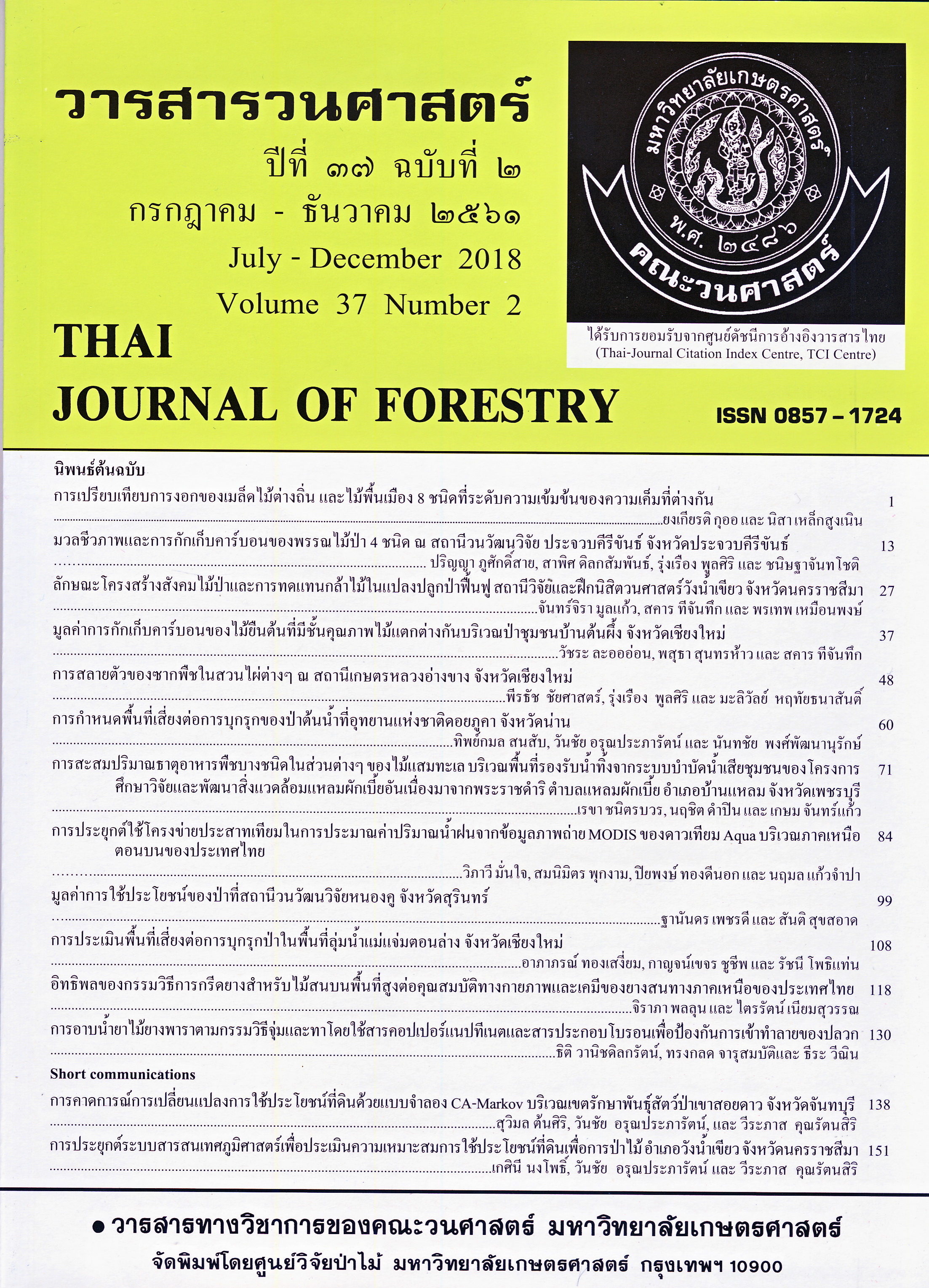การประยุกต์ใช้โครงข่ายประสาทเทียมในการประมาณค่าปริมาณน้ำฝนจากข้อมูลภาพถ่าย MODIS ของดาวเทียม Aqua บริเวณภาคเหนือตอนบนของประเทศไทย
Main Article Content
บทคัดย่อ
การวิจัยในครั้งนี้มีวัตถุประสงค์เพื่อประมาณค่าปริมาณน้ำฝนจากข้อมูลภาพถ่าย MODIS ของดาวเทียม Aqua โดยใช้แบบจำลองโครงข่ายประสาทเทียม (Artificial Neural Network; ANN) ในพื้นที่ภาคเหนือตอนบนของประเทศไทย โดยใช้ข้อมูลปริมาณน้ำฝนที่ตรวจวัดจากสถานีอุตุนิยมวิทยาและคุณสมบัติของเมฆ 6 ปัจจัย จากข้อมูลภาพถ่าย MODIS ของดาวเทียม Aqua ซึ่งประกอบด้วย อุณหภูมิส่องสว่าง (Brightness Temperature; BT) ความกดอากาศยอดเมฆ (Cloud Top Pressure; CTP) อุณหภูมิยอดเมฆ (Cloud Top Temperature; CTT) ความทึบแสง (Cloud Optical Thickness; COT) ของเหลวในเมฆ (Cloud Water Path; CWP) และไอน้ำ (Cloud Water Vapor; CWV) ระหว่างเดือนมกราคม พ.ศ. 2557 ถึงเดือนธันวาคม พ.ศ. 2558 มาใช้สำหรับการสร้างแบบจำลอง และใช้ข้อมูลปี พ.ศ. 2559 สำหรับการทดสอบความถูกต้องและการสอบเทียบความถูกต้องโดยใช้ค่ารากของค่าคลาดเคลื่อนกำลังสองเฉลี่ย (Root Mean Square Error; RMSE) ค่าความคลาดเคลื่อนสัมบูรณ์เฉลี่ย (Mean Absolute Error; MAE) และค่าความผิดพลาดโดยประมาณ (Approximate Percentage Error; PE)
ผลการศึกษาพบว่า ปริมาณน้ำฝนเฉลี่ยรายปี พ.ศ. 2557 และปี พ.ศ. 2558 มีค่าเท่ากับ 1,231.31 และ 1,078.86 มม. ตามลำดับ โดยมีค่าสูงในระหว่างเดือนกรกฎาคม – กันยายน มีค่าต่ำในระหว่างเดือนธันวาคม - มกราคม และจากการศึกษาคุณสมบัติของเมฆจากข้อมูลภาพ MODIS ดาวเทียม Aqua พบว่า BT, CTP และ CTT มีค่าต่ำในระหว่างเดือนพฤษภาคม – กันยายน ส่วน COT, CWP และ CWV มีค่าสูงในระหว่างเดือนพฤษภาคม – ตุลาคม ซึ่งสอดคล้องกับช่วงที่ปริมาณน้ำฝนมีค่าสูงในระหว่างเดือนนี้ ส่วนการศึกษาความสัมพันธ์ระหว่างปริมาณน้ำฝนกับคุณสมบัติของเมฆจากข้อมูลภาพ MODIS ดาวเทียม Aqua รายปี พบว่า CTP มีความสัมพันธ์กับปริมาณน้ำฝนมากที่สุด มีค่าสัมประสิทธิ์สหสัมพันธ์ (r) เท่ากับ 0.90 รองลงมาคือ BT, CWP, CTT, CWV และ COT มีค่า เท่ากับ 0.87, 0.86, 0.84, 0.84 และ 0.83 ตามลำดับ สำหรับฤดูฝน พบว่า BT มีความสัมพันธ์กับปริมาณน้ำฝนมากที่สุด โดยมีค่า r เท่ากับ 0.91 รองลงมาคือ COT, CWP, CTT, CTP และ CWV มีค่าเท่ากับ 0.85, 0.82, 0.80, 0.79 และ 0.76 ตามลำดับ ส่วนการประมาณค่าปริมาณน้ำฝนจากแบบจำลอง ANN รายปีและฤดูฝน พบว่า มีค่า r เท่ากับ 0.99 และ 0.99 ตามลำดับ การตรวจสอบความถูกต้องของแบบจำลอง (Model Validation) พบว่า ปริมาณน้ำฝนที่ได้จากแบบจำลองมีค่าต่ำกว่า (Underestimate) ปริมาณน้ำฝนตรวจวัดจริง โดยมีค่าความคลาดเคลื่อนของแบบจำลองรายปีจากวิธี RMSE MAE และ PE เท่ากับ 7.96 10.3 และ 15.21 ส่วนฤดูฝนมีค่าเท่ากับ 7.57 5.96 และ 36.17 ตามลำดับ
Downloads
Article Details
ข้าพเจ้าและผู้เขียนร่วม (ถ้ามี) ขอรับรองว่า ต้นฉบับที่เสนอมานี้ยังไม่เคยได้รับการตีพิมพ์และไม่ได้อยู่ในระหว่างกระบวนการพิจารณาตีพิมพ์ลงในวารสารหรือสิ่งตีพิมพ์อื่นใด ข้าพเจ้าและผู้เขียนร่วม (ถ้ามี) ยอมรับหลักเกณฑ์และเงื่อนไขการพิจารณาต้นฉบับ ทั้งยินยอมให้กองบรรณาธิการมีสิทธิ์พิจารณาและตรวจแก้ต้นฉบับได้ตามที่เห็นสมควร พร้อมนี้ขอมอบลิขสิทธิ์ผลงานที่ได้รับการตีพิมพ์ให้แก่วารสารวนศาสตร์ คณะวนศาสตร์ มหาวิทยาลัยเกษตรศาสตร์ กรณีมีการฟ้องร้องเรื่องการละเมิดลิขสิทธิ์เกี่ยวกับภาพ กราฟ ข้อความส่วนใดส่วนหนึ่ง หรือ ข้อคิดเห็นที่ปรากฏในผลงาน ให้เป็นความรับผิดชอบของข้าพเจ้าและผู้เขียนร่วม (ถ้ามี) แต่เพียงฝ่ายเดียว และหากข้าพเจ้าและผู้เขียนร่วม (ถ้ามี) ประสงค์ถอนบทความในระหว่างกระบวนการพิจารณาของทางวารสาร ข้าพเจ้าและผู้เขียนร่วม (ถ้ามี) ยินดีรับผิดชอบค่าใช้จ่ายทั้งหมดที่เกิดขึ้นในกระบวนการพิจารณาบทความนั้น”
เอกสารอ้างอิง
กรมอุตุนิยมวิทยา. 2553. General Metorogy. แหล่งที่มา: http://hydro-1.net/08HYDRO/HD-10/102/General% 20Metorogy.pdf, 25 เมษายน 2560.
กรมอุตุนิยมวิทยา. 2558. รายงานอุตุนิยมวิทยาเกษตร มกราคม 2558. 19 หน้า.
กรมอุตุนิยมวิทยา. 2559. รายงานอุตุนิยมวิทยาเกษตร กรกฎาคม 2559. 26 หน้า.
จงกลนี วาณิชย์เสริมกุล. 2528. การใช้ภาพถ่ายดาวเทียมอุตุนิยมวิทยาศึกษาทิศทางการเคลื่อนตัวและผลกระทบของพายุหมุนเขตร้อนในประเทศไทย. วิทยานิพนธ์ปริญญาโท, มหาวิทยาลัยเกษตรศาสตร์.
จตุพร ผดุงกาญจน์. 2555. ผลของปรากฏการณ์เอลนีโญและลานีญาต่อปริมาณน้ำฝน อุณหภูมิอากาศและปริมาณน้ำท่าในพื้นที่ลุ่มน้ำแม่แตง เชิญ และคลองยัน. วิทยานิพนธ์ปริญญาโท, มหาวิทยาลัยเกษตรศาสตร์.
ชลาลัย แจ่มผล. 2558. ปรากฏการณ์เอลนีโญ 2558/59. วารสารอุตุนิยมวิทยา 15 (3): 1-5.
ทวี ชัยพิมลผลิน. 2557. บทบาทของแบบจำลองโครงข่ายประสาทเทียมสำหรับงานวิจัยทางด้านภูมิศาสตร์ในประเทศไทย. วารสารสังคมศาสตร์ มหาวิทยาลัยศรีนครินทรวิโรฒ 17: 315-327.
นิรัติยา ใจเสียง. 2551. การจำแนกสายพันธ์ข้าวจากองค์ประกอบสารระเหยในเมล็ดข้าวโดยใช้โครงข่ายประสาทเทียม. วิทยานิพนธ์ปริญญาโท, มหาวิทยาลัยเชียงใหม่.
พงษ์ศักดิ์ อยู่หุ่น. 2545. ความชื้น อุณหภูมิ และความเสถียรของบรรยากาศ. แหล่งที่มา: http://conf.agi.nu.ac.th/webnewasp/ereading/101302/04.pdf, 29 เมษายน 2560.
เพ็ญพร นิ่มนวล. 2552. การพัฒนาแบบจำลองสำหรับคำนวณปริมาณฝนจากข้อมูลภาพถ่ายดาวเทียมสำหรับประเทศไทย. วิทยานิพนธ์ปริญญาโท, มหาวิทยาลัยศิลปากร.
ฟาตา มรรษทวี. 2557. การประยุกต์ใช้แบบจำลองโครงข่ายประสาทเทียมและภาพถ่ายดาวเทียม FY-2E ในการประเมินค่าปริมาณน้ำฝนในประเทศ. วิทยานิพนธ์ปริญญาโท, มหาวิทยาลัยเกษตรศาสตร์.
ฟาตา มรรษทวี. และปิยพงษ์ ทองดีนอก. 2556. การประมาณค่าปริมาณน้ำฝนโดยใช้ภาพถ่ายดาวเทียม FY-2E และแบบจำลองโครงข่ายประสาทเทียมในประเทศไทย. วารสารวนศาสตร์ 32(พิเศษ): 238-247.
สุรัตน์ กำแพงแก้ว, ศิรินทรา อินทร์ถนอม, เสาวนีย์ ศรีชาย และวรธันย์ วิชาคุณ. 2556. การศึกษาข้อมูลสถิติการปกคลุมของเมฆในประเทศไทย. ใน รายงานการประชุมวิชาการเทคโนโลยีอวกาศและภูมิสารสนเทศแห่งชาติ ประจำปี 2556 ครั้งที่ 12. สำนักงานพัฒนาเทคโนโลยีอวกาศและภูมิสารสนเทศ (องค์การมหาชน), นนทบุรี.
เสรี ศุภราทิตย์. 2544. คู่มือการพยากรณ์น้ำโดยโครงข่ายประสาทเทียม. สถาบันพัฒนาการชลประทาน, นนทบุรี.
หทัย เพลงวัฒนา. 2558. เมฆและการเกิดเมฆ. แหล่งที่มา: http://earthscience.ipst.ac.th/wp-content/uploads/sites/19/2015/04, 19 เมษายน 2560.
โอม ไทย. 2550. การประยุกต์แบบจำลองโครงข่ายประสาทเทียมสำหรับการประเมินน้ำท่าในลุ่มน้ำย่อยของลุ่มน้ำปิงตอนบนที่ไม่มีสถานีวัดน้ำท่า. วิทยานิพนธ์ปริญญาโท, มหาวิทยาลัยเกษตรศาสตร์.
Barnston, A. G. 1992. Correspondence among the correlation, RMSE, and Heidke forecast verification measures; Refinement of the Heidke Score. Journal of Cell Science 7: 699-709.
Boger, Z. and H. Guterman. 1997. Knowledge Extraction from Artificial Neural Network Models. IEEE Systems, Man, and Cybernetics Conference. Orlando, Florida.
Dobby, E. H. G. 1967. Southeast Asia. Hazell Watson & Winey Ltd, London.
Herman, A., V.B. Kumar, P.A. Arkin and J.V. Kousky. 1997. Objectively determined 10-day African rainfall estimates created for famine early warning systems. Int. J. Rem. 18 (10): 2147-2159.
National Aeronautics and Space Administration (NASA). 2014. MODIS. Available Source: https://modis.gsfc.nasa.gov/data, April 8, 2018.
Kalnary, E. 2003. Atmospheric Modeling Data Assimilation and Predictability. CambridgeUniversity Press, Cambridge.
Kniffka A., M. Stengel, M. Lockhoff, R. Bennartz and R. Hollmann. 2014. Characteristics of cloud liquid water path from SEVIRI onboard the Meteosat Second Generation 2 satellite for several cloud types. Atmos. Meas. Tech. 7 (4): 887–905.
Seiki, T. and T. Nakajima. 2014. Aerosol effects of the condensation process on a convective cloud simulation. J. Atmos. Sci. 71 (2): 833–853.
Willmott, C. J. and K. Matsuura. 2005. Advantages of the mean absolute error (MAE) over the root mean square error (RMSE) in assessing average model performance. Journal of Climate Research 30 (1): 79-82.
World Meteorological Organization (WMO). 2015. El Nino/La Nina Update. Available Source: http://www.wmo.int/pages/prog/wcp/wcasp/documents/WMO_ENSO_Nov15_Eng.pdf, April 16, 2017.
World Meteorological Organization (WMO). 2017. Optical Thickness. Available Source: https://cloudatlas.wmo.int/optical-thickness.html, May 2, 2017.


